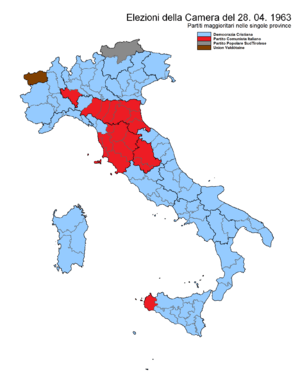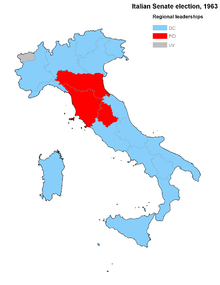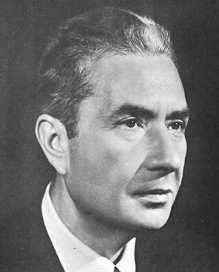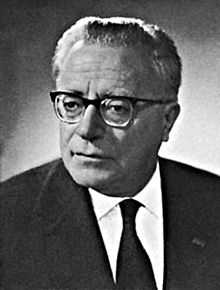Italian general election, 1963
Italian general election, 1963

|
|
|
|
|

|
| Legislative election results map. Light Blue denotes provinces with a Christian Democratic plurality, Red denotes those with a Communist plurality, Gray denotes those with an Autonomist plurality. |
|
General elections were held in Italy on April 28, 1963, to select the Fourth Republican Parliament.[1] It was the first election with a fixed number of MPs to be elected, as decided by the second Constitutional Reform in February 1963.[2] It was also the first election which saw the Secretary of Christian Democracy to refuse the office of Prime Minister after the vote, at least for six months, preferring to provisionally maintain his more influent post at the head of the party: this fact confirmed the transformation of Italian political system into a particracy, the secretaries of the parties having become more powerful than the Parliament and the Government.[3]
Electoral system

Regional pluralities in Senate
The pure party-list proportional representation had traditionally become the electoral system for the Chamber of Deputies. Italian provinces were united in 32 constituencies, each electing a group of candidates. At constituency level, seats were divided between open lists using the largest remainder method with Imperiali quota. Remaining votes and seats were transferred at national level, where they was divided using the Hare quota, and automatically distributed to best losers into the local lists.
For the Senate, 237 single-seat constituencies were established, even if the assembly had risen to 315 members. The candidates needed a landslide victory of two thirds of votes to be elected, a goal which could be reached only by the German minorities in South Tirol. All remained votes and seats were grouped in party lists and regional constituencies, where a D'Hondt method was used: inside the lists, candidates with the best percentages were elected.
Parties and leaders
Results
The election fell after the launch of the centre-left formula by the Christian Democracy, a coalition based upon the alliance with the Socialist Party which had left its alignment with the Soviet Union. Some rightist electors abandoned the DC for the Liberal Party, which was asking for a centre-right government and received votes also from the quarrelsome monarchist area. The majority party so decided to replace incumbent Premier Amintore Fanfani with a provisional administration led by impartial Speaker of the House, Giovanni Leone; however, when the congress of the PSI in autumn authorized a full engagement of the party into the government, Leone resigned and Aldo Moro, secretary of the DC and leader of the more leftist wing of the party, became the new Prime Minister and ruled Italy for more than four years, ever passing through two resolved political crisis caused even by the detachment of the left wing of the PSI, which created the PSIUP and returned to the alliance with the Communists, and by disagreements into the governmental coalition.
Chamber of Deputies

Composition of the Chamber of Deputies after the election.
| Party |
Votes |
% |
Seats |
+/– |
|---|
|
Christian Democracy | 11,773,182 | 38.28 | 260 | –13 |
|
Italian Communist Party | 7,767,601 | 25.26 | 166 | +16 |
|
Italian Socialist Party | 4,255,836 | 13.84 | 87 | +3 |
|
Italian Liberal Party | 2,144,270 | 6.97 | 39 | +22 |
|
Italian Democratic Socialist Party | 1,876,271 | 6.10 | 33 | +11 |
|
Italian Social Movement | 1,570,282 | 5.11 | 27 | +3 |
|
Italian Democratic Party of Monarchist Unity | 536,948 | 1.75 | 8 | –17 |
|
Italian Republican Party | 420,213 | 1.37 | 6 | – |
|
South Tyrolean People's Party | 135,457 | 0.44 | 3 | – |
|
Concentration Rural Unity | 92,209 | 0.30 | 0 | – |
|
Autonomous Party of Pensioners of Italy | 87,655 | 0.29 | 0 | New |
|
Valdostan Union | 31,844 | 0.10 | 1 | – |
|
Others | 61,103 | 0.19 | 0 | – |
| Invalid/blank votes | 1,013,138 | – | – | – |
| Total | 31,766,009 | 100 | 630 | +34 |
| Registered voters/turnout | 34,199,184 | 92.89 | – | – |
| Source: Ministry of the Interior |
Senate of the Republic

Composition of the Senate after the election.
| Party |
Votes |
% |
Seats |
+/– |
|---|
|
Christian Democracy | 10,017,975 | 36.47 | 129 | +6 |
|
Italian Communist Party | 6,933,310 | 25.24 | 84 | +25 |
|
Italian Socialist Party | 3,849,495 | 14.01 | 44 | +9 |
|
Italian Liberal Party | 2,043,323 | 7.44 | 18 | +14 |
|
Italian Democratic Socialist Party | 1,743,870 | 6.35 | 14 | +9 |
|
Italian Social Movement | 1,458,917 | 5.31 | 14 | +6 |
|
Italian Democratic Party of Monarchist Unity | 429,412 | 1.56 | 2 | –5 |
|
Italian Republican Party | 223,350 | 0.81 | 0 | – |
|
MSI-PDIUM | 212,381 | 0.77 | 1 | +1 |
|
DC-PRI | 199,805 | 0.73 | 4 | - |
|
South Tyrolean People's Party | 112,023 | 0.41 | 2 | – |
|
Concentration Rural Unity | 58,064 | 0.21 | 0 | New |
|
Social Christian Autonomist Party | 43,355 | 0.16 | 1 | New |
|
Sardinian Action Party | 34,954 | 0.13 | 0 | – |
|
Valdostan Union | 29,510 | 0.11 | 1 | +1 |
|
Others | 79,558 | 0.29 | 1 | +1 |
| Invalid/blank votes | 2,273,406 | – | – | – |
| Total | 28,872,052 | 100 | 315 | +69 |
| Registered voters/turnout | 31,019,233 | 93.0 | – | – |
| Source: Ministry of the Interior |
References
- ↑ Nohlen, D & Stöver, P (2010) Elections in Europe: A data handbook, p1048 ISBN 978-3-8329-5609-7
- ↑ Constitutional Reform number 2 decided a fixed number of 630 member for the House, under the example of the British House of Commons during that period, and of 315 for the Senate, with a minimum of seven senators for each region excluding Aosta Valley and, later, Molise. This reform is still in force.
- ↑ Italian electors effectively lost any chance to decide their Prime Minister until the majoritarian reform of 1993.
External links






